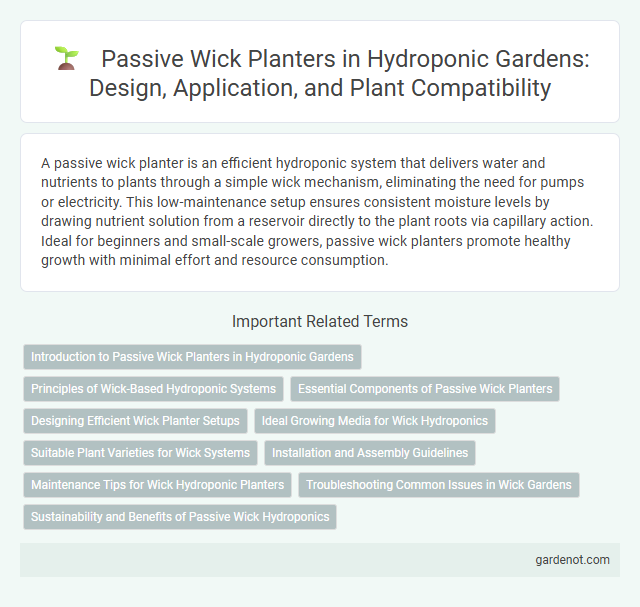A passive wick planter is an efficient hydroponic system that delivers water and nutrients to plants through a simple wick mechanism, eliminating the need for pumps or electricity. This low-maintenance setup ensures consistent moisture levels by drawing nutrient solution from a reservoir directly to the plant roots via capillary action. Ideal for beginners and small-scale growers, passive wick planters promote healthy growth with minimal effort and resource consumption.
Introduction to Passive Wick Planters in Hydroponic Gardens
Passive wick planters utilize capillary action to transport nutrient-rich water from a reservoir to plant roots, making them an efficient, soil-free growing method in hydroponic gardens. These systems require minimal maintenance and no electricity, ideal for small-scale or beginner hydroponic setups. Common materials include cotton or nylon wicks, which provide consistent moisture, promoting healthy plant growth and reducing the risk of root rot.
Principles of Wick-Based Hydroponic Systems
Passive wick planters operate on the principle of capillary action, where a wick made from absorbent material draws nutrient solution from a reservoir to the plant roots. This system relies on consistent moisture delivery without the need for pumps or electricity, making it energy-efficient and low-maintenance. Optimal wick materials, such as cotton or nylon, enhance nutrient uptake by maintaining steady moisture levels essential for healthy hydroponic plant growth.
Essential Components of Passive Wick Planters
Passive wick planters consist of three essential components: a nutrient reservoir, an absorbent wick, and the growing medium. The wick acts as a capillary channel, drawing nutrient solution from the reservoir directly to the plant roots, ensuring consistent moisture levels without the need for pumps or electricity. Common wick materials include cotton, nylon, or polyester, selected for their water retention and durability in hydroponic landscapes.
Designing Efficient Wick Planter Setups
Designing efficient passive wick planter setups involves selecting highly absorbent wicking materials such as cotton or nylon to ensure consistent nutrient delivery to hydroponic plants. Positioning the wick to maintain optimal moisture levels in the growing medium prevents root dehydration and promotes robust plant growth. Incorporating a deep reservoir in the system stabilizes water availability, reducing maintenance frequency and enhancing overall nutrient uptake efficiency.
Ideal Growing Media for Wick Hydroponics
Ideal growing media for wick hydroponics include coconut coir, perlite, and vermiculite, which provide excellent water retention and aeration. These passive wick planters rely on capillary action, so a lightweight, porous medium ensures consistent nutrient delivery without waterlogging. Combining these substrates supports healthy root development and maximizes plant growth efficiency.
Suitable Plant Varieties for Wick Systems
Passive wick planters are ideal for growing herbs like basil, mint, and parsley due to their low water requirements and consistent moisture availability. Leafy greens such as lettuce, spinach, and arugula thrive in wick systems because the passive water delivery supports steady root hydration without over-saturation. These plant varieties benefit from the passive wick system's ability to maintain a balanced reservoir of nutrients, promoting healthy growth in hydroponic landscapes.
Installation and Assembly Guidelines
The installation of a passive wick planter involves selecting a suitable container with adequate drainage and filling it with a lightweight, moisture-retentive growing medium such as coconut coir or perlite. Assemble by positioning the wick material--typically cotton or nylon rope--through the container's base to ensure continuous water flow from the reservoir to the plant roots. Proper placement of the planter above the water reservoir and regular monitoring of wick saturation are essential to maintain optimal moisture levels for healthy hydroponic growth.
Maintenance Tips for Wick Hydroponic Planters
Maintaining wick hydroponic planters requires regular inspection to ensure the wick remains saturated and free from blockages, promoting efficient nutrient uptake. Clean the wick material every few weeks to prevent algae buildup and replace it if frayed or degraded, preserving optimal water flow. Monitoring the nutrient solution's pH and concentration frequently helps sustain a balanced environment for healthy plant growth in passive wick systems.
Troubleshooting Common Issues in Wick Gardens
Passive wick planters often face issues such as uneven water distribution, root rot, and wick saturation problems, which can hinder plant growth in hydroponic landscapes. Ensuring the wick material is appropriately absorbent and regularly checking for blockages or dry spots can restore optimal water flow to the roots. Maintaining water quality and monitoring moisture levels helps prevent nutrient deficiencies and promotes healthy development in wick gardens.
Sustainability and Benefits of Passive Wick Hydroponics
Passive wick hydroponics offers a sustainable gardening solution by minimizing water waste through capillary action, ensuring consistent moisture delivery without electricity or pumps. This method reduces the need for soil, chemical fertilizers, and excess water consumption, promoting eco-friendly plant growth in urban and resource-limited environments. Benefits include low maintenance, energy efficiency, and the ability to support diverse plant species while conserving resources and reducing environmental impact.
Passive wick planter Infographic

 gardenot.com
gardenot.com